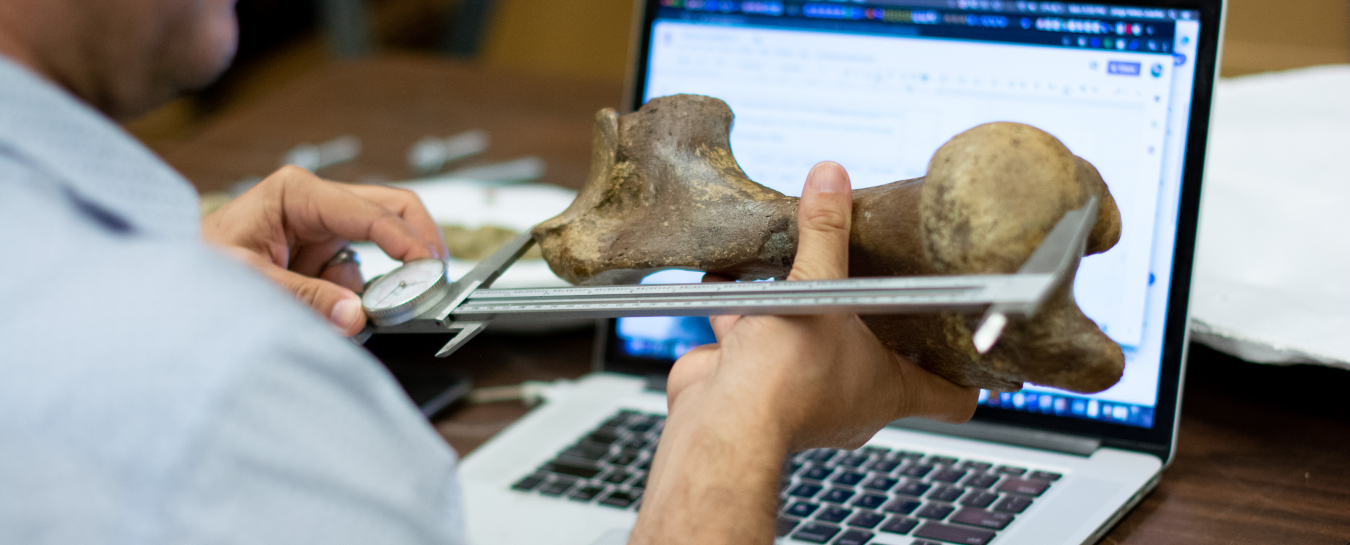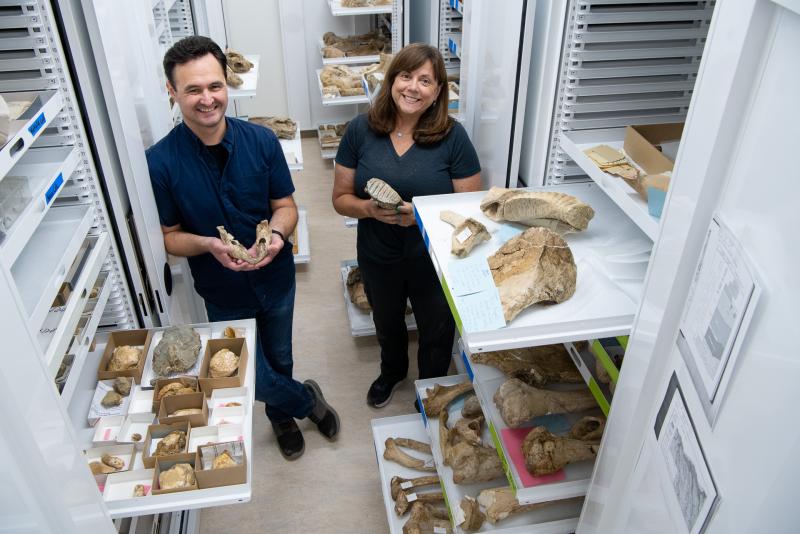
Earth Sciences
The Dibblee Geology Center
The Dibblee Geology Center (DGC) is funded by the Dibblee Endowment, created through the generosity of Thomas W. Dibblee, with the objective to support field work and research to advance education in geology. Thomas Dibblee was a prolific geologic mapper, documenting and interpreting the geology of over a quarter of California. The DGC was initially responsible for publishing and digitizing the Dibblee geologic maps, and all 419 geologic maps and field guides are now available through the Museum Store. Today, DGC staff curate the Museum's Earth Science Collection and collaborate with various government agencies to conserve our region’s amazing paleontological and geological resources. This is made possible with new facilities like a spacious, renovated collection range and new fossil preparation laboratory.
Quick Resources
- Find out more about local geology and paleontology
- Browse our identifications of rocks and fossils
- Email jhoffman@sbnature2.org if you found something special
- Environmental consulting services
- Buy Dibblee geologic maps
- Buy Dibblee field guides
Support Our Efforts
For more information about the Dibblee Geology Center—or to donate to support the endowment—contact Museum President & CEO Luke J. Swetland at lswetland@sbnature2.org or 805-682-4711 ext. 101.
Staff
Dibblee Curator of Earth Science Jonathan M. Hoffman, Ph.D.
Dr. Hoffman’s program focuses on the paleontological resource management of the public lands that make up the greater Santa Barbara region (San Luis Obispo, Santa Barbara, and Ventura Counties). Through collaborations with federal, state, county, and municipal agencies, Hoffman is building an Earth Science Collection and repository that reflects the paleontological and geological history of the Santa Barbara region. Hoffman’s research focuses on the paleoecology and taxonomy of extinct mammals, including the Channel Islands Pygmy Mammoth and Santa Rosa Island dugongid.
Curatorial Assistant Elizabeth Flint, J.D.
Flint assists with curation of the Earth Science Collection. She is currently working on reattaching and refining the locality data to specimens collected by former Curator of Paleontology and Anthropology Phil C. Orr.

Facilities and Loans
The Earth Science Collection (ESC) is housed in modern metal cabinets, sorted by locality. The mineral component of the ESC is composed of both regional specimens and donated collections from around the world. The fossil portion of the collection holds four holotype specimens: Pyrus hoffmanni Chaney and Mason, 1933; Imagotaria downsi Mitchell, 1968; Osteodontornis orri Howard, 1957; and Phalacrocorax rogersi Howard, 1932. The ESC fossils are primarily from Santa Barbara, San Luis Obispo, and Ventura Counties.
The Museum proudly serves as the repository for natural history specimens from Channel Islands National Park. Dibblee Geology Center staff curate the fossils collected from the park, including Ice Age pygmy mammoths and ancient marine mammals like the first sea cow found on the Channel Islands. For more information, explore the geology of Channel Islands National Park or browse the CINP paleontological resource inventory.
Researchers interested in accessing the ESC or borrowing specimens can contact Dr. Hoffman at jhoffman@sbnature2.org or 805-682-4711 ext. 157.
Dig deep into the story of the Channel Islands sea cow in the video above.
History and Major Collections
Earth sciences have played a role at the Museum since its inception: Dr. Lynds Jones, an ornithologist and instructor at Oberlin College, was a friend of Museum founder William Leon Dawson. Dr. Jones collected copper ore on a trip to the Pacific Northwest in September of 1916 to donate to his friend’s new museum. Since then, numerous donors and scientists have helped build the ESC. Some of the major contributors are:
Charles Doug Woodhouse (1888–1975) was a geologist, mine superintendent, the first geology professor at University of California Santa Barbara (then Santa Barbara State College), and a Museum trustee for decades. Doug Woodhouse traveled the globe to visit mines and was one of the biggest donors for the mineral collection, donating roughly 7% of the current collection. His son Chuck would eventually become the Museum's curator of marine mammalogy.
Ed Harrison (1914–2002) was a Los Angeles businessman and wildlife photographer who founded the Western Foundation for Vertebrate Zoology in Ventura and was a Museum trustee for many years. Portions of his massive and diverse natural history collections were donated to the Museum, with the minerals constituting roughly 20% of the current mineral collection.
Edwin and Jean Womack fed a lifelong hobby by amassing a wonderful collection of over 1,000 different ammonites. The Womack Collection offers a wide array of types of mineralization and fossilization, making it a natural choice for teaching the public about these processes. Several Womack ammonites are featured on the wall of ammonites in the Museum's ongoing mineral exhibit.
Robert Lavinsky, Ph.D. is an accomplished mineral collector, dealer, and proprietor of The Arkenstone in Dallas, Texas. Lavinsky selected some of his favorite specimens from his personal collection for a summer 2022 collaborative exhibit with the Museum, the highly-acclaimed Rare Earth. At the end of the show’s run, he donated prized specimens to the Museum, including a large piece of Woodhouseite (named for the abovementioned Charles Doug Woodhouse) and the beautifully iridescent ammolite featured on the wall of ammonites in the Museum's ongoing mineral exhibit.
Environmental Consulting Services
The Dibblee Geology Center provides support for environmental consulting projects in Santa Barbara, San Luis Obispo, and Ventura Counties in the form of fossil locality records searches, repository agreements, and renting laboratory space. For information about fees and processing time, please contact Dr. Hoffman at jhoffman@sbnature2.org or 805-682-4711 ext. 157.
Presentations
Flint, Elizabeth G. & Hoffman, Jonathan M. Can you dig it? A lawyer’s advice on securing permission to excavate fossils exemplified by a recent Miocene mysticete excavation in Santa Barbara County, California. Society of Vertebrate Paleontology Annual Meeting, Minneapolis, Minnesota, USA. 2024.
Flint, Elizabeth G. & Hoffman, Jonathan M. Reviving the Santa Barbara Museum of Natural History’s Pygmy Mammoth Fossil Legacy Collection to Foster New Research. Association for Materials & Methods in Paleontology Annual Meeting, Morden, Manitoba, Canada. 2024.
Mead, Jim & Jonathan Hoffman. A transitional Mammuthus (Larramendy mammoth skull; Elephantidae), Santa Rosa Island, Channel Islands National Park, California. 10th California Islands Symposium, Ventura, California. 2023.
Caruso, Anthony, Poust, Ashley, Powel, Charles, II, and Jonathan Hoffman. Biostratigraphic and paleoenvironmental Interpratations of an early Miocene invertebrate assemblage associated with sirenian fossils on Santa Rosa Island. 10th California Islands Symposium, Ventura, California. 2023.
Paces, James B., Minor, Scott A., Schmidt, Kevin M., and Jonathan Hoffman. Holy (sea) cow! An earliest Miocene age for Santa Rosa Island dugong fossils using Sr-Isotope geochronology. 10th California Islands Symposium, Ventura, California. 2023.
Publications
Paces, James B., Minor, Scott A., Schmidt, Kevin M., and Hoffman, Jonathan. 2023 Strontium isotope chronostratigraphic age of a sirenian fossil site on Santa Rosa Island, Channel Islands National Park, California: U.S. Geological Survey Scientific Investigations Report 2023-5026. 27 p.
Tweet, Justin S., Santucci, Vince L., Convery Ken, Hoffman, Jonathan, and Kirn, Laura. 2020 Channel Islands National Park: Paleontological resource inventory (public version). Natural Resource Report. NPS/CHIS/NRR—2020/2171. National Park Service. Fort Collins, Colorado.
Htun, Thien, Prothero, Donlad R., Hoffman, Jonathan M., Lukowski, Stephanie M. and Syverson, V.J.P. 2018. Allometric trends in dwarfing in the extinct Pleistocene Channel Islands Pygmy Mammoth, Mammuthus exilis. New Mexico Museum of Natural History and Science Bulletin, vol. 79, pp. 261-265.

